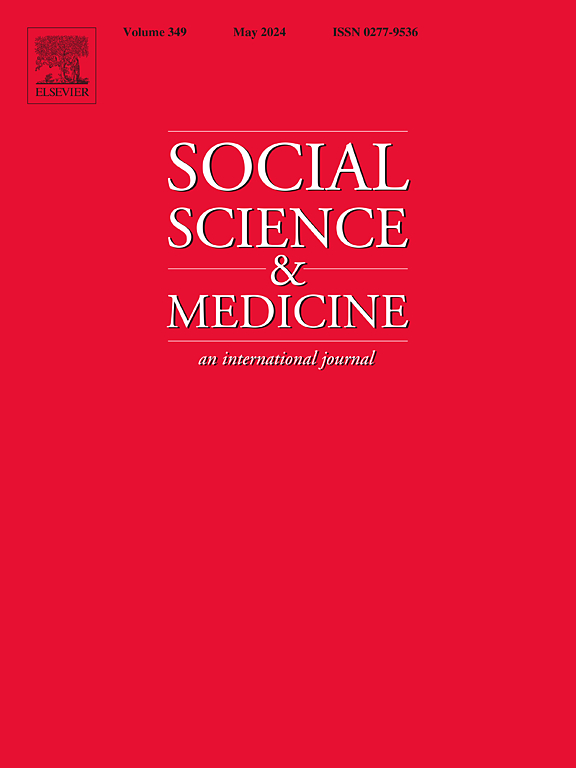产前和产后护理中的交叉社会不平等:检查种族,民族,社会经济地位和地理位置。
IF 5
2区 医学
Q1 PUBLIC, ENVIRONMENTAL & OCCUPATIONAL HEALTH
引用次数: 0
摘要
现有研究记录了产前和产后护理利用的差异。本研究引入了一种新的方法,通过整合抑制护理使用的多种结构因素来检查孕产妇保健差距。主要,我们研究交叉的社会不平等,以了解种族/民族,社会经济地位和地理位置如何相互作用地影响分娩个体的产科护理使用。利用2016-2021年妊娠风险评估监测系统(PRAMS) (N = 177,480)、Gadson概念模型和交叉方法的数据,我们研究了美国记录教育状况和居住地对产科护理使用影响的种族差异。我们发现,与非拉丁裔白人相比,边缘化种族/族裔群体(包括非拉丁裔黑人、非拉丁裔“其他”和拉丁裔)产前和产后护理利用的可能性明显较低。即使受过高等教育(16年及以上),这些群体对充分、充分加产前(超过建议)和产后护理(仅针对拉丁裔)的利用率也较低。我们进一步记录了教育影响的城乡差距,与具有相似教育特征的农村非拉丁裔黑人相比,受教育年限较高(16年及以上)的农村非拉丁裔黑人、受教育程度较低(9-11年)的农村非拉丁裔黑人和其他受教育程度较低(9-11年)的农村非拉丁裔白人使用适当的产前护理的可能性相对较低。我们呼吁在医疗保健和其他影响健康的因素方面进行改革,优先考虑包容性和平等,减少偏见和偏见的看法,以改善弱势群体的孕产妇保健和结果。本文章由计算机程序翻译,如有差异,请以英文原文为准。
Intersecting social inequalities in prenatal and postnatal care: Examining race, ethnicity, socioeconomic status, and geographic location
Existing research document disparities in prenatal and postnatal care utilization. This research introduces a novel approach for examining maternal healthcare disparities by integrating multiple structural factors that inhibit care usage. Principally, we examine intersecting social inequalities to understand how race/ethnicity, socioeconomic status, and geographic location interactively shape obstetric care usage for individuals who give birth. Drawing data from the 2016–2021 Pregnancy Risk Assessment Monitoring System (PRAMS) (N = 177,480), the Gadson conceptual model, and intersectional approach, we examine the racial divide in the effects of documented education status and residence on obstetric care usage in the United States. We found a significantly lower likelihood of both prenatal and postnatal care utilization among marginalized racial/ethnic groups, including non-Latina Black, non-Latina ‘Other’, and Latinas, as compared to non-Latina White individuals. These groups also had lower utilization of adequate, adequate plus prenatal (more than recommended), and post-natal care (for only Latinas), even when highly educated (16 years of education and more). We further documented the rural-urban gaps in the effect of education where rural non-Latina Black individuals with more years of education (16 years and more), rural Latina and rural non-Latina other who are slightly educated (9–11 years of education) had a relatively lower likelihood of using adequate plus prenatal care, as compared to rural non-Latina White with similar education characteristics. We call for reforms in healthcare and other factors affecting health that prioritize inclusivity and equality, and reduce bias and perceptions of bias to improve maternal healthcare and outcomes among vulnerable groups.
求助全文
通过发布文献求助,成功后即可免费获取论文全文。
去求助
来源期刊

Social Science & Medicine
PUBLIC, ENVIRONMENTAL & OCCUPATIONAL HEALTH-
CiteScore
9.10
自引率
5.60%
发文量
762
审稿时长
38 days
期刊介绍:
Social Science & Medicine provides an international and interdisciplinary forum for the dissemination of social science research on health. We publish original research articles (both empirical and theoretical), reviews, position papers and commentaries on health issues, to inform current research, policy and practice in all areas of common interest to social scientists, health practitioners, and policy makers. The journal publishes material relevant to any aspect of health from a wide range of social science disciplines (anthropology, economics, epidemiology, geography, policy, psychology, and sociology), and material relevant to the social sciences from any of the professions concerned with physical and mental health, health care, clinical practice, and health policy and organization. We encourage material which is of general interest to an international readership.
 求助内容:
求助内容: 应助结果提醒方式:
应助结果提醒方式:


